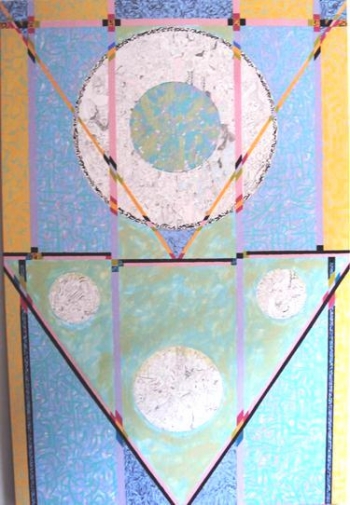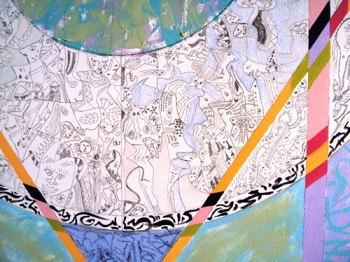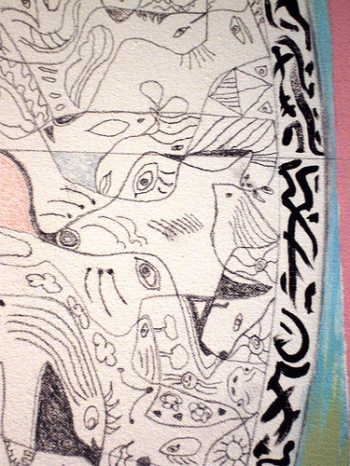Of the Nichiren tradition, Suzanne is an artist and manages Westminster Lotus Sangha in London. Her work brings together contemporary influences as well as Buddhist themes, resulting in a fascinating unity of harmonious contrasts and poetic contexts. Visit her website here: www.suzannereesglanister.co.uk
I have been a Buddhist for over thirty years, and practise a form of Nichiren Buddhism based on the Lotus Sutra. When I think about why I first became a Buddhist, I often think of my early childhood. I was born in Wales, but shortly after the war my family went to live in Hanover, Germany where my father was posted in the British army. I remember most of all the poverty and destruction. This was perhaps where my path to Buddhism started. My parents encouraged me to play with the local children and I became very aware of how little they had, and how unequal things were. My friend, who was a twin, only ever had one piece of bread and jam; when I told my mother, she invited them around as often as she could. This was enlightened behaviour in those post-war years, and gave me a foundation for my later Buddhist practice.
From Germany we went to Sri Lanka (then Ceylon) where my father was a hydro-electric engineer building dams. I saw poverty in a different way here – disease, kids begging round cars. It was there I started to love colour – my friend with a sari would dip it in the stream and it would come out shimmering with fishes. And the birds were the colours of jewels. Humming birds for example, made kingfishers look quite dull beside them. The colours of the costumes, the grasses, the flowers, the trees had huge wax-like flowers all created a great impression on me. Then I became interested in Indian paintings, and I first saw Buddhist paintings in Kandy.
It was in Sri Lanka that I got polio and couldn’t attend school. My Welsh grandmother read me stories all the time. Every time I surfaced I would hear her reading stories, another influence on my art. Later we went to Africa, to Nigeria and Ghana, but my mother died when I was still a child and I was sent to boarding school in England. All these elements had their effect on my later development, as a Buddhist and an artist.
When I left school, I lived in London and started to go to the theatre a lot. I went more and more, and then studied theatre and design, which was fascinating. I did sets and costumes – much preferred making models to sewing, and still do. I was fortunate to work for the designer Sean Kenny, and later for Jocelyn Herbert who was at the Royal Court and put me up for an Arts Council bursary. I worked for Jocelyn at the Royal Court for four years – did new John Osborne and Pinter plays. I learnt so much from her. Then I set off on my own to Birmingham, to Dundee, to the Edinburgh Festival, the Traverse and the Lyceum theatres.
Then I got married and had three children. It was difficult to keep on the theatre work because of the hours, so I began teaching art. It was because of that I got into painting, started doing things that were very detailed. My painting has developed alongside my Buddhist practice, ranging from a series of paintings of the old people in sheltered housing where I worked, to paintings inspired by the 18th century woman haiku master Chiyo-ni, and others motivated by my love for music. When I started reading haikus, I found that I loved their directness. I like to try to use that kind of space in a painting.
More recently I had the opportunity to participate in an interfaith course, ‘Faiths Together’ at Heythrop College, London. This further enabled me to explore some of the insights and symbolism of religions other than my own.
I am inclined to paint in series. My latest series is based on the Lotus Sutra, which are reputed to be the teachings of Shakyamuni Buddha. Some of the drawing is influenced by manga, and some by Chinese and Japanese calligraphy. I am not a calligrapher myself, but the feeling of calligraphy underlies some of my work. The colour, too, is specific to how I understand the Lotus Sutra. The act of drawing can become a form of meditation, where the subconscious takes over, and I can be quite surprised by the outcome.
I’ve always loved the Japanese culture, especially medieval and 19th century art, and mid 20th century Japanese films.
What you leave out is very important. I have always been interested in the Chinese philosophy that everything must not be perfect. A painting has to have a bit of darkness and the other side of life. A human is someone who has great love, beauty and compassion but also in everyone there is evil, darkness and destruction.
My paintings are only truly finished when they are seen by others, the function of my painting is to express my ideas and to create paintings of beauty and understanding of life.....this is a big ask, however, sometimes when it succeeds it is an amazing feeling of fulfilment. I would like the viewers to walk away from one of my paintings and feel they have enjoyed life a little more because of my work.

















